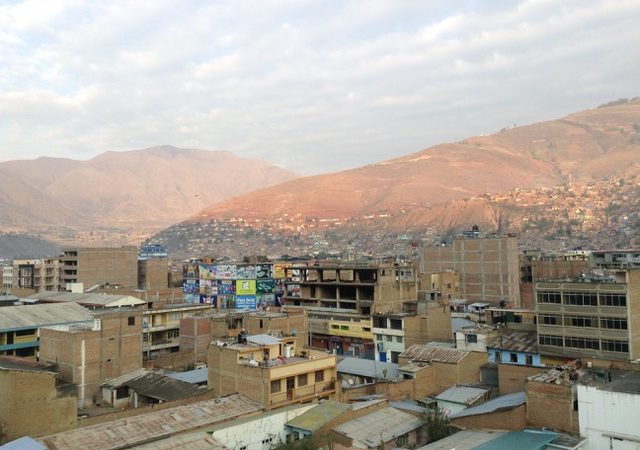Georgina Chapman, Ottawa ON — From a young age, I have always travelled. Born and raised in Kent, England, it was easy to jump on a plane and be in France by lunchtime. However, it wasn’t until my family and I immigrated to Canada and I started university that I began to realise just how little I knew of the world. Most of my holiday destinations had been in affluent countries – safe and stable. During my first year, my uncle – who worked for an overseas mission organisation – contacted me asking if I was interested in going on a medical mission trip to Peru. As an enthusiastic Biomedical Science student, I couldn’t say “YES!” fast enough. That August, I jumped on a plane bound for Lima with a team of 10 medical personnel. We had 3 doctors, 3 nurses, a pharmacist, some translators, and myself. I was, by far, the least educated person on the team. I had no idea what my role would be, and I CERTAINLY wasn’t ready for what I was about to see…
Peru is a beautiful country, and remains to this day one of my favourite places on Earth. We landed in Lima, slept a night, then boarded a “bus” to an area to the north of Lima called Chancay.
… you may be thinking, “What does this have to do with Neuroscience?”. Hold on. I’m getting there…
The goal of the trip was to set up pop-up clinics in several villages around the Chancay area and invite the locals to visit us (since there was no hospital nearby). I was stationed in the “pharmacy”, which was essentially a table under a tarp on the side of the road. I bounced around fulfilling prescriptions and helping the doctors out. It was on this trip that I heard my first heart murmur with a stethoscope, and helped prep my first needle.
About half way through the trip, one of the doctors called me into the hut he was using as his doctors’ office. In the room sat an old man. The doctor asked me what I noticed about him, and if I knew what his ailment might me. I clocked something straight away. The left half of his face was drooping. “Easy!” I thought. “He’s had a stroke” I said. The doctor smiled at me and said “Good guess, but no. This man has Bell’s Palsy”. Both humbled and intrigued, I asked further. Bell’s Palsy is caused by damage to the facial nerve, or 5th cervical nerve. Exactly how this man developed it is hard to tell, but I learned two things that day: firstly, things aren’t always what they seem, and secondly, I have a LOT to learn.
The next day, the doctor called me in again to observe another patient; an elderly woman with sleeplessness, lack of appetite, and generally low energy. The doctor did a general examination (the women in this area wrap blankets and scarfs around their torsos to make themselves look bigger. What a backwards world we live in…) and found that the woman was healthy, albeit a little thin. The doctor proceeded to ask her questions about her life, and she told him that her son had been killed in a motorcycle accident two weeks before. From there, the diagnosis was simple.
This woman was depressed.
How do you explain depression to an elderly woman in rural Peru? The doctor took the woman’s hand and said, “my dear, you are suffering from a broken heart”. It was as if the realisation hit her like a flood, and she began to cry. I don’t suppose I will ever forget that day.
Fast forward a few years, and I’m in a church building in Huanuco, Peru. Another pop-up clinic. Two very, VERY elderly ladies walk into our clinic. They had their son drive them down from a mountain village to see us. They were about 4ft tall, wearing traditional Quechuan apparel, and came in holding hands. It took 2 translators to speak to them (one translating from Quechuan to Spanish, the other from Spanish to English) and we determined that one of the women had rather severe dementia. They were the sweetest of ladies, and bore the most beautiful image of sisterly love and commitment I have ever encountered.
In subsequent trips to Peru and to Ghana, I have seen a mother with a panic disorder, a teen with encephalopathy, a 12-year-old rape victim with PTSD, autism, chronic stress and depression, to name a few.
All this to say: Mental illness is not a disease of the affluent. Its fingerprints can be seen in every country and culture. In my experience overseas, the concepts of depression, anxiety, and neurodevelopmental disorder are discussed more as an outcome of a persons’ weak constitution (or of demon-possession, in some areas) than an illness in its own right. Yet, this mentality is not localised to the Third World. We often see the same mind set in our own culture.
How do we address this?
Awareness. This is why SfN Ottawa do what they do. The more informed we are on current issues and research, the better we can understand one another. Go to a seminar, volunteer for Brain Awareness week. Get involved! The more you learn, the more you know.
Acknowledgements: A big thank you to my uncle, Peter, who gave me the ‘Mission-Bug’, and to Dr. Steve Wilbraham, who always made an effort to teach me new things.
Georgina is a first-year PhD student in the Department of Neuroscience at Carleton University. She is working under the supervisorship of Dr. Patrice Smith, looking specifically at neuroplasticity after Stroke. She is a new member of the Society for Neuroscience Ottawa Chapter and is excited to help make neuroscience an accessible field of research in the Capital City.
